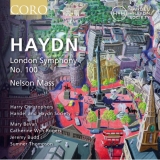 Joseph Haydn: Symphonie Nr. 100 + Nelson Messe; Mary Bevan, Sopran, Catherine Wyn-Rogers, Mezzosopran, Jeremy Budd, Tenor, Sumner Thompson, Bariton, Handel and Haydn Society, Harry Christophers; 1 CD Coro COR16181; Aufnahme 01/2020, Veröffentlichung 11/2020 (64'47) - Rezension von Uwe Krusch
Joseph Haydn: Symphonie Nr. 100 + Nelson Messe; Mary Bevan, Sopran, Catherine Wyn-Rogers, Mezzosopran, Jeremy Budd, Tenor, Sumner Thompson, Bariton, Handel and Haydn Society, Harry Christophers; 1 CD Coro COR16181; Aufnahme 01/2020, Veröffentlichung 11/2020 (64'47) - Rezension von Uwe Krusch
Harry Christophers ist mit Chor und Orchester der Handel and Haydn Society dabei, eine neue Aufnahmereihe vorzulegen, bei der er jeweils eine Londoner Symphonie und eine Messe von Joseph Haydn kombiniert. Im zweiten Teil hat er die 100., als Militär-Symphonie bezeichnet, mit der Missa in Angustiis, auch Nelson-Messe genannt, assoziiert. Das ist insofern nachvollziehbar, als beide einen Bezug zu den Kriegszeiten haben, in denen sie geschaffen wurden.
Das schlägt sich in den hörbaren Ergebnissen nieder, da Blechbläser und Schlagwerke hervorgehoben eingesetzt werden. Für die Symphonie bedient sich Christopher deshalb besonderer Instrumente. Die Basstrommel entspricht in ihren Abmessungen der türkischen Duval, einer zweifelligen Zylindertrommel. Außerdem wird ein in diesem Kulturraum gebräuchlicher Schellenbaum genutzt neben Cymbal, Pauke und Triangel. Diese Instrumente entfalten den besonderen Janitscharenklang.
Beide Stücke werden mit großem Elan und Drang angeboten, so dass sie viel Energie verströmen. Allerdings wird diese in geordnete Bahnen gelenkt. Wie bei den Einspielungen dieses Ensembles üblich erzielen sie sehr gut ausgewogene und eben hier lebhafte Ergebnisse.
Die vier Gesangssolisten bereichern die Aufnahme zusätzlich. Zwar mag man sich manche Note noch schöner geformt vorstellen oder bei den Männerstimmen noch unangestrengter, aber grundsätzlich gestalten die vier Einzelstimmen ihre Partien mit dem Werk angepasster Stimmgestaltung mit zurückgenommenem Vibrato und geschmackvoller Linienführung.
Harry Christophers is currently working with the choir and orchestra of the Handel and Haydn Society on a new series of recordings, each combining a London Symphony and a Mass by Joseph Haydn. In the second part he has associated the 100th, known as the Military Symphony, with the Missa in Angustiis, also known as the Nelson Mass. This is understandable because both works refer to the wartime period in which they were created.
This is underlined, as brass and percussion instruments are used in a prominent way. Christopher uses special instruments for the Symphony. The bass drum has the same dimensions as the Turkish Duval, a cylindrical drum. In addition, a jingling tree common in this cultural area is used alongside cymbal, timpani and triangle. These instruments produce the special janissary sound.
Both pieces are performed with great vigour and urgency. However, this energy is not exaggerated. As is usual with the recordings of this ensemble, they achieve very well balanced and lively results.
The four vocal soloists further enrich the performance. Although one might imagine some notes to be even more beautifully shaped or, in the case of the male voices, less strained, the four individual voices basically shape their parts with restrained vibrato and tasteful lines.






















